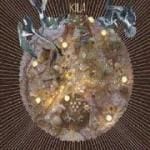
“The composition of the group has always varied quite effortlessly according to the needs of the band and the people in it,” explains the band biography on Kiila’s website. Their work on Tuota Tuota is characterised by that kind of flow, as if the musicians are always saying, “There’s an interesting path. We have time. Let’s follow it.” Bells chime, fiddles zither, someone hums, the music wanders into a twang, then away. There is singing, then no singing, then something else. Tuota Tuota is the Finnish group’s third full-length album, the sixth entry in its discography if you include the three EPs that came before 2001’s Heartcore, all released through Fonal, a label whose experimental-wayward-freakfolk sensibility fits the music neatly. It seems a small output for a group that has been around since 1993. The original duo of Niko-Matti Ahti and Sami Sänpäkkilä has expanded to a more or less regular line-up of six, with others coming in as needed.
Starting in one genre, tracks end in another, picking a motif and working through it in different ways. The sawing neatness of Finnish folk instruments is a constant theme: the creak of a fiddle, a fit pluck, a playful acoustic precision. A woman arrives in “Niin Kuin Puut” and sings in a low, vibrating drone. Rock music turns up, and so does a sort of American-cowboy twang. At other times the musicians stroll between genres, testing different noises as they figure out where they might decide to go next. The journey rarely seems aimless, which is one of the best things about it. Tuota Tuota sounds semi-improvised but not the way a jam does — it doesn’t have that loose splurgy feel — and the apparently non-ironic presence of rock music means that it doesn’t sound entirely like avant-garde jazz-folk either, as some other Fonal releases do. It doesn’t ask the listener to discover secret fairy forests at the bottom of the garden — again: as some other Fonal releases do — and its organic feel comes solely from that sense of exploration, the movement of people finding pathways between one thing and another. There is something minimalist in their precision and economy, but their work is not minimalist. There is an average-guy amiability to it, and this, too, I think, comes down to the use of familiar things, of rock.
The album ends with a crash: everything boils together and buzzes and swoops and twiddles saxophonically to a halt as if the musicians have given up exploring and decided to bang their jazz saucepans together and run away. After more than 30 minutes of inventiveness, this ending seems too pat, too easy, not up to the intelligence of the preceding half-hour. Before that there are some moments of real exhilaration, which, thanks to the roaming structure of the music, seem to come along serendipitously. It’s a different kind of exhilaration to the kind you get from a song that follows the popular pattern of verse/chorus/verse. There’s something unplanned about it, and unrepeatable. It’s not a catchy hook, in other words, or a smart groove. It’s as if you’ve met someone who has been searching for something for ages and while you’re with them they point to the ground by your feet, and say, “Look, there it is.”

![Call for Papers: All Things Reconsidered [MUSIC] May-August 2024](https://www.popmatters.com/wp-content/uploads/2024/04/all-things-reconsidered-call-music-may-2024-720x380.jpg)



